
300.クリス(続編?)
先日、近県の方からいただいたメールをきっかけにクリスについて、もう少し紹介しましょう。といっても別のHPの紹介なのですが。
内容が事実なのかどうか、そこまではワカリマセン。ものずきな私にとっては興味深いというだけで、ごく普通の方にはまったく面白くない退屈なだけかも。
そこで、興味をさそうようなことを先にして、肝心の紹介(面白くない)は後のほうにします。
221話で出てきたクリス工房
シドゥメンの松原さんのブログに工房の住所もあります(手間省くなよ~)
場所はクルンクンあたりで「クリスの鍛冶屋」を尋ねればわかるでしょう。
なにしろ親方は有名人ですから。(だから、チャンと書けよ~)
クリスの持ち帰り
221話で尻切れトンボになっていた購入の続きです。
そこでは、刀剣類としてキチンと警察・教育委員会の許可がいる、と説明しました。
私と同じくクリスに興味を持つ方が同様にトライして断念したことを最近知りました。
残念ながら、個人で銃刀法に該当する寸法・形状のクリスは門前払いということです。
要するに美術品に類する日本刀だけが対象であり、それ以外はダメということ。
(包丁・ナタなどはどうか? 料理や農業などで使うぶんには許可不要ですが、繁華街で持ち歩くとダメ)
その方は私以上に相当ガンバッタのですが。
 刃渡り5.5cm未満でないとダメ
刃渡り5.5cm未満でないとダメ
クリスの部分の呼び名
マレー・ジャワ・スラウェシ・バリなど地方により呼び名は違うと思いますが、以下はマレークリスの場合です。
柄:ukiran
鞘:gandar 鞘の根元が鍔のようになった部分:wrangka
刀身:birah 日本刀のように刃と棟に分けていない
茎(なかご):pesi
刃紋:pamor 日本刀と違い削りだして模様を出す
クリスの形状
曲がりlukに意味はありますが、むしろ真っ直ぐlurusなクリスが一般的。
曲がりの数は奇数に決まっていますが、先端での曲がりは見分けにくいものもある。
クリスの形を現す言葉は3つあります。
Dapor 曲がっているlukか、真っ直ぐlurusか
Perabot 鍔元の刀身の飾り彫り
Pamor 刀身の模様
これらに加えて鞘・柄も材質・形状・飾りなどが多種多様です。
さらに、クリスを飾る台もこれまた趣味の世界に溺れるようです。
刃紋pamorのいろいろ
Pamorは2種類の鋼材(炭素鋼とニッケル鋼)をミルフィーユのように重ね合わせて
さらに鍛えて溝を彫り表面を研ぎ出して意図する模様が出てくるので
日本刀に比べてパターンの自由度が極めて高いのです。
その例を次に示します。
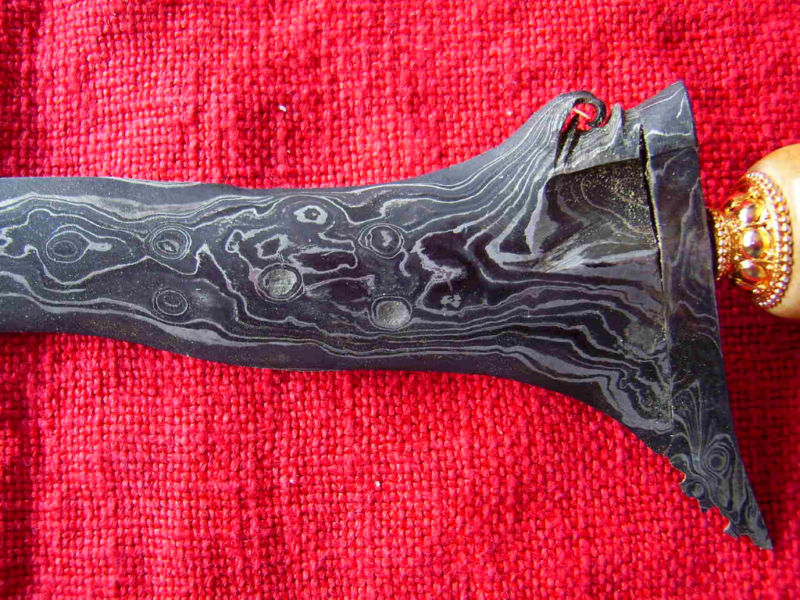
よく見るパターンですが、模様の層数が少ない。(手抜き)
目玉がいくつか脱落しているのは鍛接が甘いから。(手抜き)
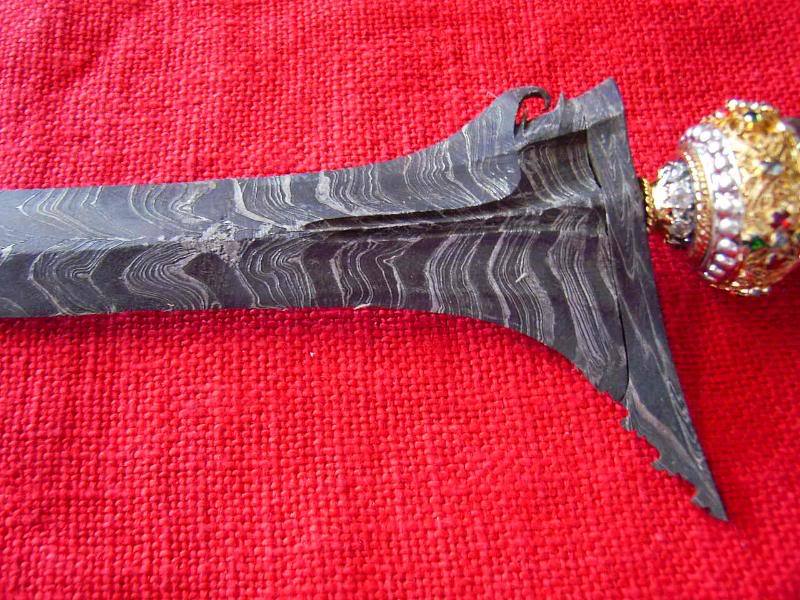
模様が何と刀身と直角になっており、強さを度外視して作った(鍛冶が大変)
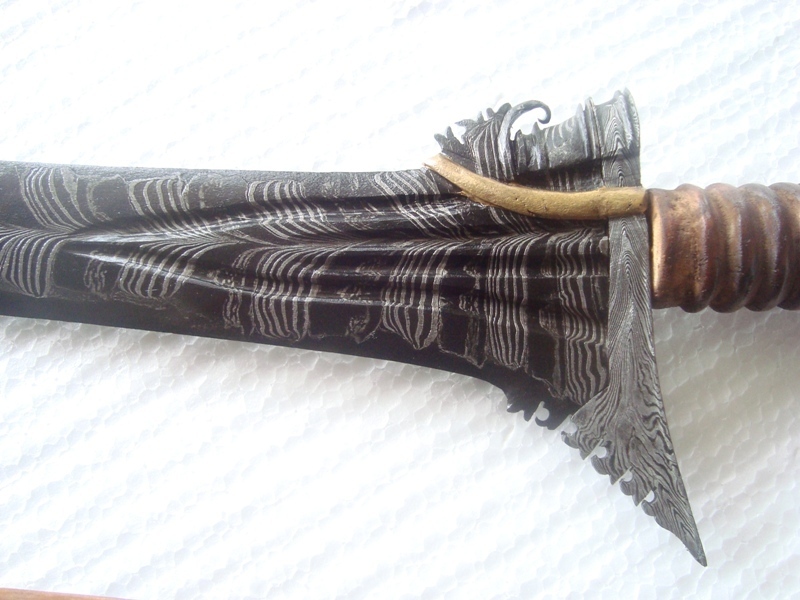
これはさらに手が込んでおり、刃の部分には模様がないのと鍔元の模様が全く違うことから
大きく4つのパーツ(刃・両側2枚・鍔)を別々に鍛え、それを1つに鍛接したと想像。
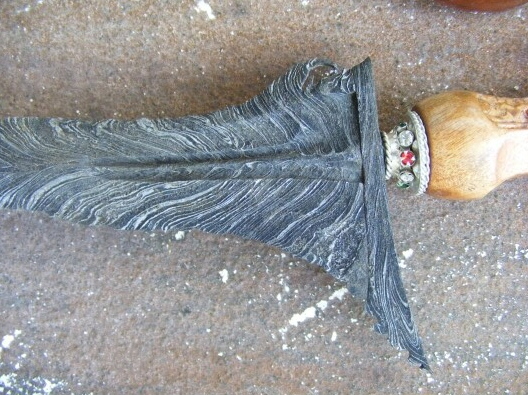
何のイメージでしょうか、炎か翼のいずれかでしょう。
一体どうやって作ったのやら。
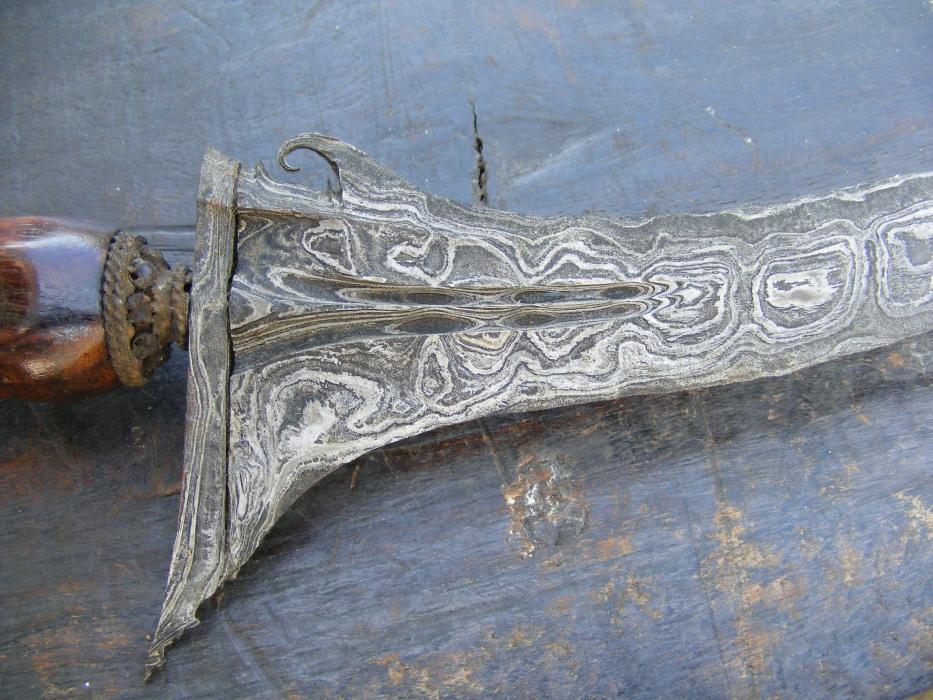
これも少し手間がかかっています。丸い模様が先端まで繰り返すのです。
刀身根元の2本の掘り込みで多層構造がよく見え、層数が比較的少ないことがわかります。
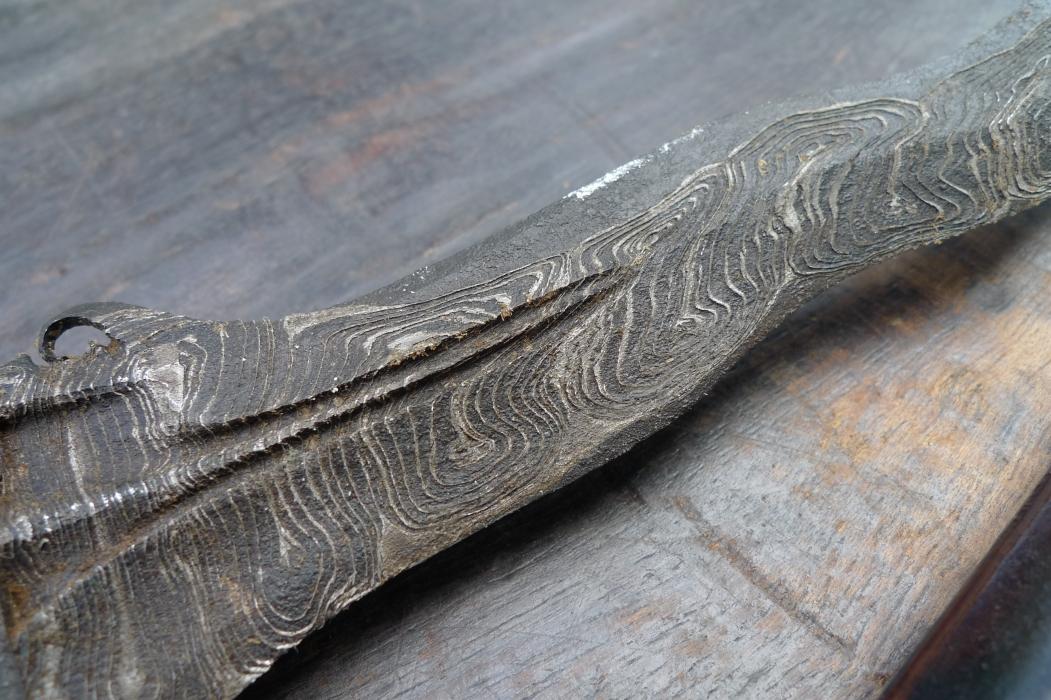
かなり状態が悪くて炭素鋼(黒い部分)が錆びて凹んでいますが、模様はとんでもなく手が込んでいます。
一見丸い模様の繰り返しに見えますが、実はS字模様(蛇のイメージ)です。
どうやって作ったのか想像できません。

こちらも錆びが進んでいますが模様の間隔が大変細かくミルフィーユ状態です。
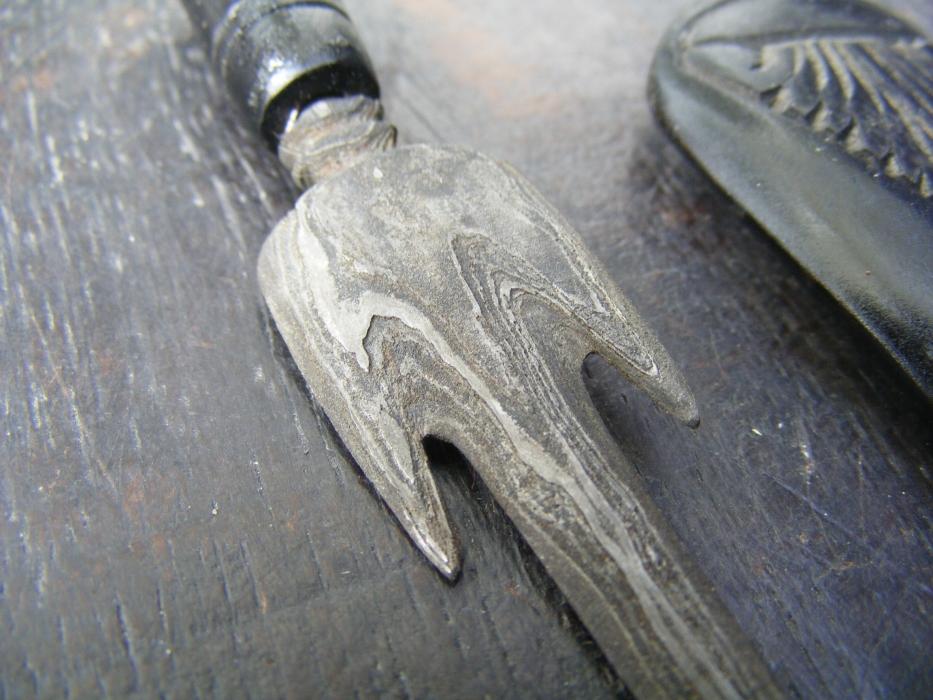
かなり小型のクリスですが3つ股は珍しいです。模様は貧弱ですが
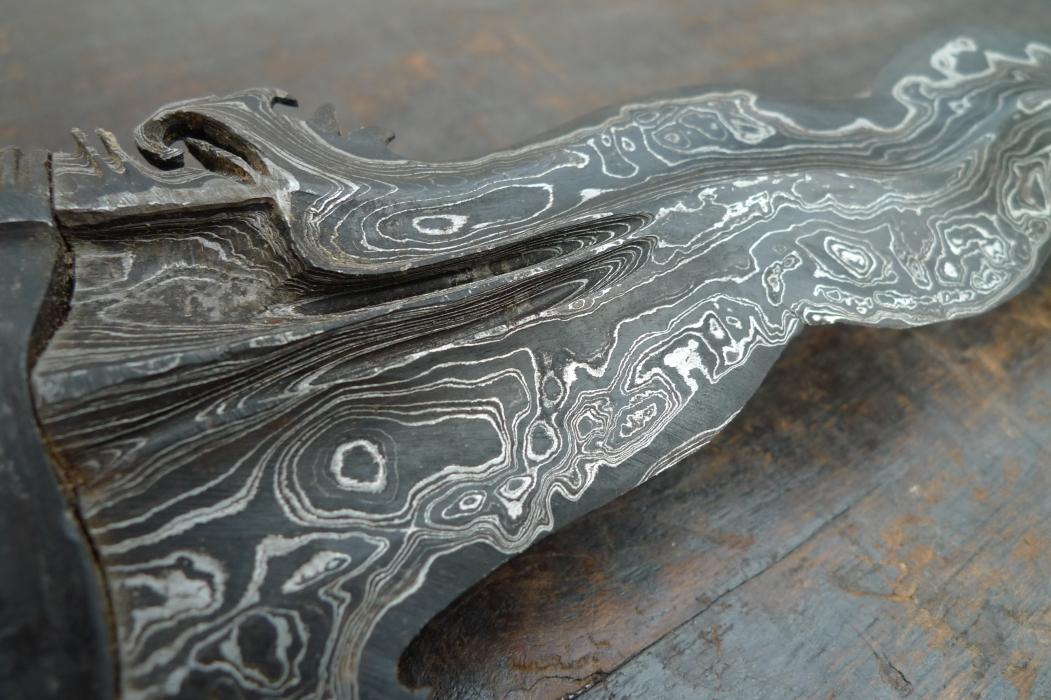
典型的なよい模様です。素人でも一目でわかります。
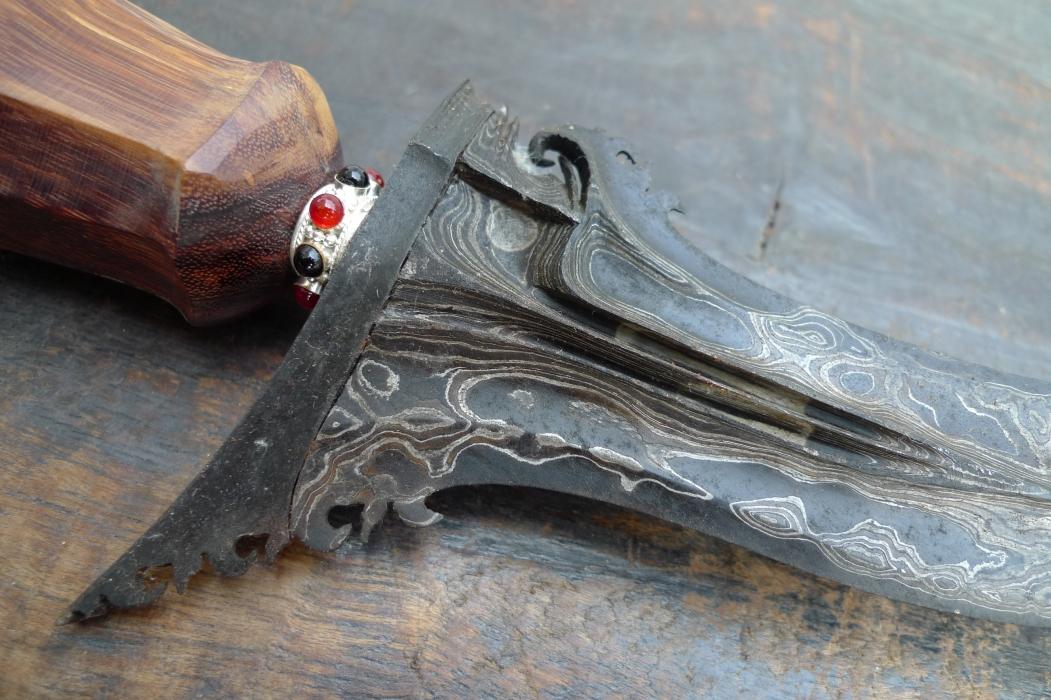
鍔は貧弱ですが模様・掘り込みは素晴らしいです。
ひょっとするとオリジナルの鍔は失われたのかも。
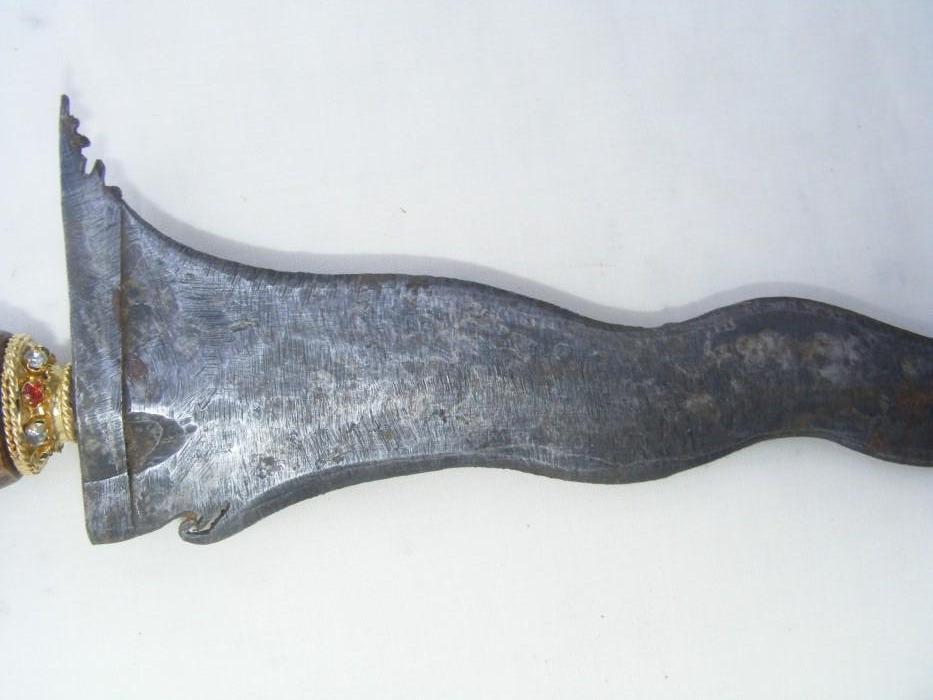
なんじゃコレ?
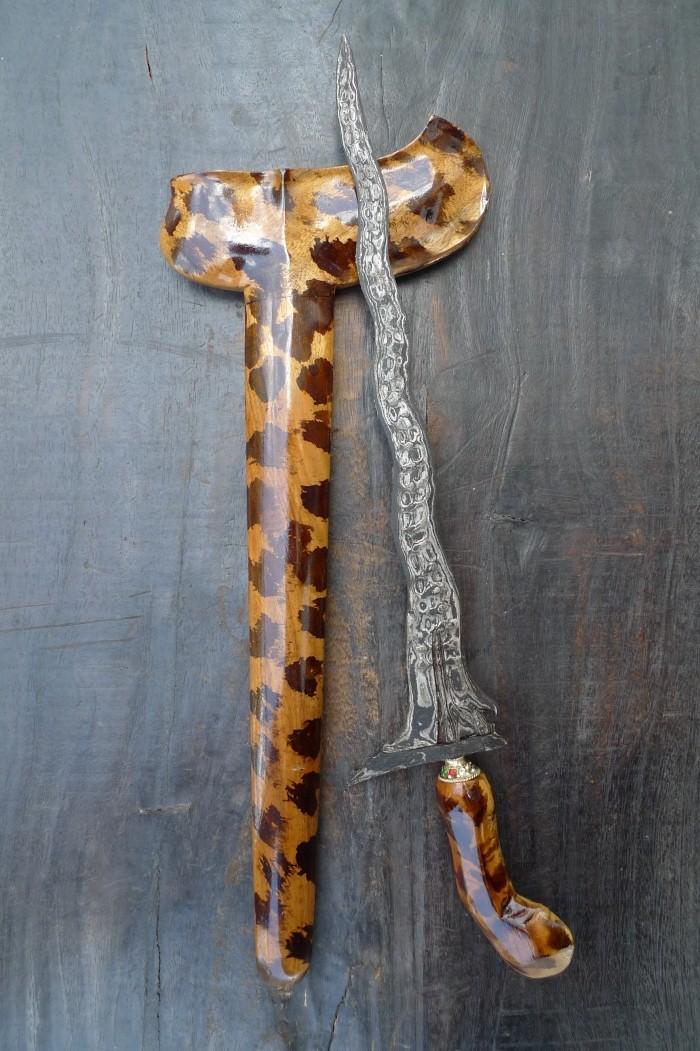
刀身よりも鞘を見てほしいのです。素晴らしい模様です。
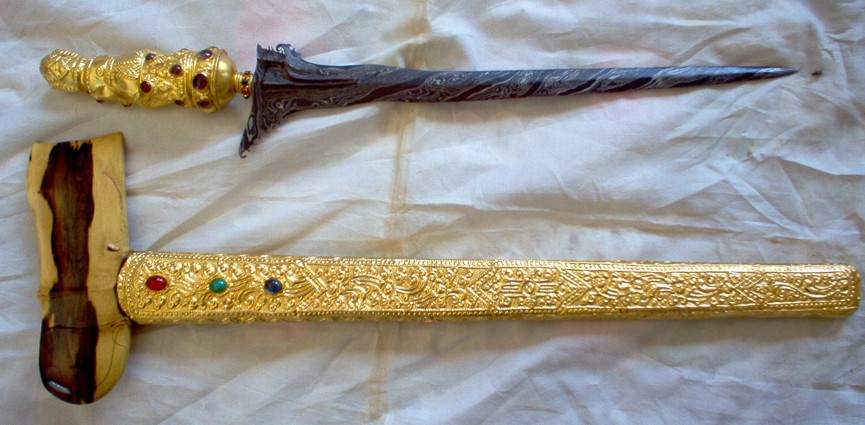
模様が刀身に斜めに入っている例です。鞘と柄はイマイチ
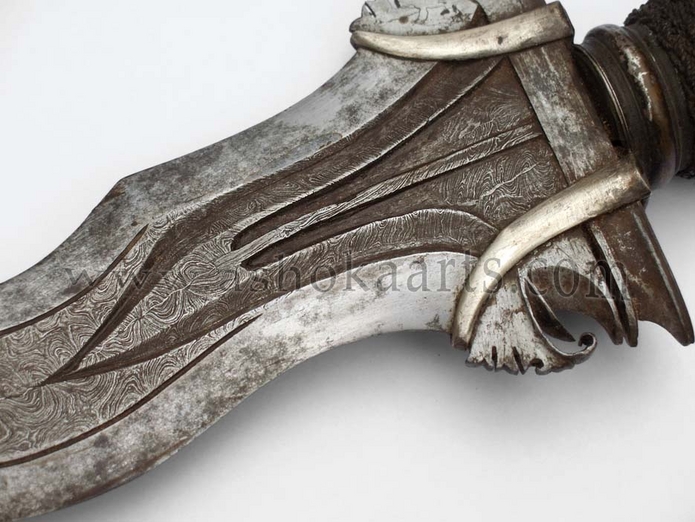
「素晴らしい模様fine pamor」とあったのですが、今一信用できないのです。
層の連続性がうまく繋がらないと思いませんか?
あとで模様を彫ったのじゃないかと。
フツーの方には以下の文章は退屈です
以前に見つけておいたクリスのHPを思い出したので翻訳紹介するのですが
The Balinese Kris バリのクリス
いろいろと興味深い(フツーの方にはそうでない)ことが書かれていてビックリです。
24 May 2007
クリスKRISとはバリの伝統的な短剣(片刃・両刃)のことで、たいていは真っ直ぐですがクネクネ曲がっていることもあります。今日ではダンス公演や重要な儀式でのみ用いられます。オランダが銃やライフルで侵攻して武器としての役割は終わりましたが、「神秘的な力をもつもの」として生き残っています。
伝統的なバリではクリスは宝石で装飾されたりして高価なものでした。クリスは男の最も大事な持ち物であり、権威と力のエッセンスでもあります。代々ひきつがれ、クリスには力が蓄積され、しばしばクリスそのものにパーソナリティが備わります。これはアーサー王の伝説にも似ています。ジンバランに神様がくれたクリスがあります。このクリスは聖なるバロンがかぶる仮面の紐を切るためにだけ使われます。ダンスが終り休息する時に体と仮面を切り離すのです。このとき以外はこのクリスは寺の特別の社に祭られているのです。あるクリスは屋根のない場所に保管されなければなりません。非常に力が強く、なにかの下(門ですら)を通ることは許されないのです。クリスの力にとり憑かれたようになってまわりの人を刺し殺すこともあると報告されています。
クリスはマレーを起源にインドネシア全域・フィリピンにまで分布しています。最も初期のクリスは東ジャワのPanataran寺院の壁彫刻にあるもので13世紀と考えられます。バリに渡るのはその1世紀後のMajapahit帝国の時代です。
鋼(ハガネ)に比べて純鉄には固さや粘り強さが足りません。銑鉄には酸化物などの不純物が含まれており、刀鍛冶の最初の仕事は不純物を減らし作業しやすい純鉄(鍛鉄)にすることです。 鍛鉄のクリスは青銅器ほど良くはありません。鍛鉄はさらに鋼にする必要があるのです。これが鍛冶屋の魔法の技術なのです。
技術の遅れていた時代の製鋼は深く訓練された技であり、2つの相反する性質(硬度と靭性)を達成するものです。鋼は鉄と微量のその他の物質(金属や炭素)の混ざったものです。現在では強度を大きくするためにモリブデンやクロムを混合し、防錆のため銅を混ぜることをします。1.5%以上の炭素を含むと鋼は脆くで柔らかくなります。バリの鍛冶屋は鋼塊を作るため、鉄を溶かし内部からガスを放出させ上から粉炭をふりかけます。これによって鋼は充分に純粋になり、かつ必要な炭素を含むことになり、金床で鍛えることができるのです。
鍛冶屋はそれからこの鋼塊をクリスに形作るため、ハンマーを使って鍛接を信じられない回数くりかえすのです。金床で熱い鋼棒を叩くことで木材のように金属粒が内部にできて強度と一体性が生まれます。伝統的なクリスはダマスカス鋼でできています、これは叩いてリボンのようにして折り返し再び叩いて鍛接し、それを繰り返す製造法です。合板の縁のようにダマスカス鋼は刃の曲面にそって目に見える層があり、層が薄くなるほど刃は強くなります。
鍛冶屋が炭素鋼とニッケル合金鋼でラミネートすると、表面に現れる模様は独特になります。ニッケル合金は炭素鋼にくらべて明るい色をしており、このラミネーションはpamorパモールと呼ばれます。最初はニッケル合金は隕鉄からしか得られませんでした。後にニッケルは中国人やブギス人貿易商によってセレベス(スラウェシ)からもたらされました。スラウェシには今も豊富な埋蔵量があります。時にはヨーロッパから輸入されたこともあります。
腕のよい鍛冶屋はパモール模様を操ることができます。刃に溝を刻んで内部も模様を出し、さらに叩いて溝を消して長い模様線を島のように切ったり鞍のように狭めるのです。いろいろな方法で各種の模様が生み出されるのです。これは手作業なので、各層厚のバラツキ・叩く力かげんによって現れる模様は変わる(予期しない模様になることも)のです。素晴らしいパモールのクリスは1本1本が独特です。 柑橘類の汁や砒素で仕上げ処理すると模様はさらに浮き出ます。炭素鋼にくらべてニッケル合金は腐食されずに白いまま残るからです。
パモールのデザインはいろいろな種類があり、私のもつ本には116種が記載されています。これらのパモールは眺めるだけのものではなく、クリスに特別な力をもたらします。1本のクリスに複数のデザインのパモールを持つこともあります。伝統的なそれぞれのパモールデザインは魔力の象徴として解釈されます。デザインはかなり標準化されており、標準化されたパターンを知っておればどんなクリスであってもそのもつ力を理解できるのです。だから誰かを傷つけるクリスであればその目標となる人物からパモールを隠しておく必要があります。クリスに力を持たせるため鍛冶屋は仕事に適切な日を選び、始まってから終わるまで炉に供物をそなえ、クリスそのものにも供えるのです。
すべてのクリスが鞘に入っているわけでもなく、真っ直ぐな外観をしているものもあります。一般に信じられているのとは違い、すべてのクリスが曲がりくねっているわけではないのです。たいていは真っ直ぐです。一部のクリスにはルッLukと呼ぶ曲がりくねりがあります。 波打つ刃は蛇の形の象徴であり、通常は蛇の頭が刃の根本(柄の下)に彫られます。柄の材質は木材だけだったり、木材の上に糸を巻きつけたり、想像もできないほど豪華に飾られた金細工だったりします。中には象牙の柄もあります。多くのものは人間を模るデザインをしています。鞘も同様にいろいろです。peretというジャワ産の斑入り木材が好まれます。私が見たジンバランのバロングループの持つものはあまり魅力的ではありませんでした。錆びているものもありました。だいたいどれも真っ直ぐの刃のクリスです。 鞘はシンプルで竹でできています。すべてのクリスが鍛冶屋の最もよい腕の製品であるとは思わないことです。
バリ社会は数霊術や数のシンボル化に非常に強く影響されています。クリスも例外ではありません。クリスの持つ不思議な力は刃の幅・長さ・持ち主の手の長さによって変わります。不適切な寸法のクリスを持つとトラブルの原因となります。アンティーククリスを破格値で提示された友人がいます。欲しかったのですが寸法を測ると、良くないことが起こるとわかり断ったそうです。
クリスの性格を知るための3つの方法があります。1つ目は単純に長さと幅を計る方法で、残りの2つは、指の幅と掌の幅に関する方法です。
刃物を計るのにバリ人は busung(ココナツの若葉)を用います。busungを刃の長さに合わせて切り、2つに折ります。これで刃の中央がわかります。次に刃の中央での幅にあわせてbusungをアコーデオンのように折り畳みます。この幅をlumbang raiと呼びます。クリスの性格はこのrai数(細長比)で決まるのです。:
10~19倍をそれぞれ神話の登場人物になぞらえている
10 rai: Kala ngamah awak ("Kala eats his body") - このクリスで持ち主が傷付く
11 rai: Durga masiyung ("Durga is with a bird") - これを所有すると持ち主とその家族に悪いことが長い間続く
12 rai: Lara muwuh ("Poverty and grief will increase") - 持ち主に悪いこと(特に病気)をもたらす
13 rai: Bima kosa krana - 持ち主はずっと平安で商売に幸運がある。軍人なら長生きできる
14 rai: Darmawangsa - 伝統薬にたづさわる人によい。祈りをする人によい。求めるものは何でも手に入る(他人から・神様から)
15 rai: Arjuna sakti ("Arjuna is powerful") - クリスの魔力で見えない敵も見えるようになる。Ksatriya階級だけがこのクリスを持てる。商売人(販売)によい。友人が増える。女性からもてる。何をしても成功する。ずっと幸運。
16 rai: Suksama angel- 生涯ずっと不幸になる。魔力が持ち主を傷つける。
17 rai: Naga-samparna - 助けはすぐに得られる。伝統薬を扱う人によい。
18 rai: Sesangkap- purna- 家に置いておくとよい。友人や家族から好かれる。旅行に持っていったり船に持ち込んではならない。
19 rai: Durga katamu ("Meeting Durga") - 旅行にはよくない。家に置いておけば問題は起こらない。悪い目的のために使うこともできるが、家の外で使わねばならない。そのあとで敵をつくってしまう。
この1番目の方法では13倍より短いクリスは良くないのです。
2番目の方法では、クリスの長さと持ち主の親指幅を用います。右手親指をクリスに直角にして鍔にあわせます。左の親指を右親指に並べ、今度は右親指を左親指の反対側に並べ、刃の先に届くまで繰り返し合計数をかぞえておきます。半端になっても1本と数えます。この数を7で割り、余りがクリスの性格を表します。例えば、16.5本とすると17となり、7で割ると2余り3。 この3で次の表から性格を読みます:
1 The kris is satriya; Ksatriyaカーストの人が持つとよい
2 The kris is ratna candra-masurya; 売る商売人によい
3 The kris is wanara cinara-cara; 王族によい
4 The kris is kala-mertyu ; Ksatriyaカーストには良くない(自分自身を傷付ける)
5 The kris is Arjuna-pasupati; 軍人のクリス。もし泥棒にあっても誰かが助けてくれる
6 The kris is kepaten twan, very bad; 誰が使っても良くない
7 The kris is dhar1naWallgsa; 高僧が使うと良い
3番目の方法は似ていますが掌に近い4本の指の根元を測ります。親指で測ったときのように、右の手の4本、左の4本と交互に繰り返します。最後に、刃にかかっている指の数がクリスの性格を表すのです:
1 This kris is sang akarya, "good behavior"; 持ち主は多くの人から慕われます
2 This kris is kalamertiyu, "it is for a person who is a good judge" 持ち主はたくさんの友人から好かれ、他人の性格を容易に読むことができる
3 This kris is kalajana, "it represents anger" 誰かから求められてクリスを使うと悪いことが起こる
4 This kris is nagawiraksa, "it is good for people who like to fight, such as Ksatriyas" 持ち主は戦いで英雄になれる
クリスを造る人は非常に重要な人とみなされており、武器を提供するというだけでなく、霊力のあるものを造る不思議な技術・力を持っていると考えられているからです。どの王様も自分自身の鍛冶屋(Pandeに属する)を持っています。Pandeが鍛冶にたずさわっていても、クリス製造は現在もごく少数の人だけが行っています。それでもPandeは普通の人とは違うものと考えられています。Pandeはpedandaから聖水をもらうことはありませんし、彼ら自身の寺と高僧さえ持っているのです。火と関係づけられるBrahmaはPandeの中では最も高位にあり、ブサキにあるPandeの寺は輝く赤色に飾られています。この色はBrahmaの色、kelodの方向(海の方向)を意味します。
鍛冶屋は力を持つクリスを造るため儀式や禁忌の日取りをよく知っていないといけません。選ばれたよい日にのみ作業するのです。毎日クリスに供え物をしなけばなりません。それでクリスが仕上げられた後と同様に象徴的に扱うのです。その時からはクリスは尊いものとして扱われます。その辺に置いて他人が持ってしまうことは避けねばなりません。特に力のあるクリスは家の寺の中の特別の社に保管し、特別な儀式でのみ持ち出すのです。オーナーによっては他人には決して触れさせません。誰かのクリスを見せてほしいと言うのは悪いマナーであり、クリスをぞんざいに扱うのも同様です。
クリスには210日ごとに特別のお供えをしなければいけません。その日はTumpek Landepと言います。Landepはバリ語で"鋭くするto be sharp"という意味で、その日には観光客は自動車やトラックなどが飾りつけられているのを目にします。すべての金属製の武器(自動車は武器に分類されます)にはお供えをするおです。ですが、クリスについての同様の儀式は目にすることはありません。それは家族の寺でのみ行われるからです。
私は1本のクリスを持っており、Tumpek Landepの日には Budiの妻のWathiが私のクリスのために鶏のお供えをしてくれます。ポーチにクリスをぶら下げ、Wathiはテーブル一杯のお供え・聖水などをささげるのです。これは闘鶏で足にゆわえるナイフTajiを思い起こさせます。これも魔力を持つと考えられているのです。鍛冶屋Pandeが鍛えるものには特別の注意が払われるのです。扱うには注意と敬意を払い、Tumpek Landepの日にはお供えを欠かさないです。
私は地元のバロングループに入るのでクリスを買いました。メンバーの必需品ではないおですが、持てば元気づけられます。クリスが物理的に強ければバロン舞踏でトランスに入るような人には必要でしょう。簡単に曲がるような弱いクリスは持っていけません。私のものは強い範疇に入るので前日にバロンの主Sopirに渡しておきます。彼の妻が特別のお供えをして祈り、バロン会場に一晩置いておくのです。舞踏に関係するときだけ使われます。
私の住む村では「クリス」という単語はあまり使いません。その代わりに婉曲な表現で「手や鞘でクリスを持つ」ということから「ベルト」という言葉を使います。この間接的な表現はバリ人がクリスの持つ力に対する敬意の表れです。例えば、バロンは非常に力強く、普通は「舞踏コスチュームpelawatan」と呼ばれます。この礼儀正しさがないと「従順でないpramada」と見なされます。
今日ではバリ人がクリスを持つのはあまり見かけません。いくつかの村、特に田舎のバリアガBali Agaの村では村人がたとえ町に行ってもクリスを持つ厳しい掟がありました。もはや強制されることはありませんが。しかし、通過儀礼のような重要な儀式では男性はクリスを差します。たいていの男性の踊り手はクリスを差します。また、バロングループのメンバーもそうです。通過儀礼や舞踏でクリスを持つとき、クリスは背中に斜めに差し、柄は右側、たすきがけの帯で巻いきます。
婚礼で象徴的な儀式があります。花婿が供え物の真ん中に置かれた小さな板を突き刺すというものです。これは突き刺して赤いブルムbremを流しだす場合もあります。この儀式は花婿の持つクリスの魔力によってペニスで処女膜を破ることを象徴しています。このようなことは文学では繰り返し語られているのですが、実際にバリ人から明示的に話すのを聞いたことは一度もありません。
私達のバロン公演ではたいてい10人以上もトランス状態になり自分の体をクリスで刺してしまいます。時には20人以上になることも。前に書いたようにたいていのクリスはごく普通で飾りもありません。100人のメンバーのうち40人くらいが自分のクリスを持っています。そのうち25本くらいが体に突き刺すのに充分な強度があります。強いクリスはたいてい厚い刃と刃身に沿ったリブがあります。
トランスに入り自分の体を刺す人のことをジンバラン地区では babutenと呼びます。彼らはバロンと拮抗する敵ランダに激怒し、自分自身を逆上させるのです。彼らの顔には緊張と憎悪が表れます。ランダがバロンを叱る場面では、彼らは座っていた席から飛びあがり、バロンのまわりで泣き、クリスを握り、観客のそばの狭い通路に押し寄せ、ランダを攻撃しようとします。私達の村ではbabutenとなった人でも実際にバロンをクリスで攻撃することはありませんが別の村では攻撃するのを見たことがあります。でもバロンは強く傷つくことはありません。ジンバランではバロンを守れなかったbabutenは寺に戻り、1時間ほど憎悪を冷まします。クリスの刃が胸につける傷のように彼らの筋肉は緊張しているのです。しかしバロンの力はクリスよりも強く誰も自分自身を傷つけることはありません。
Sometimes there is a wound, and if this occurs it is always attributed to a violation by the wounded babuten of one of the various taboos that he, as a member of the sekan barong, must observe. The pemangku then orders that the wounded man be taken into the barong's pavilion, where he treats him with holy water, a red hibiscus, sandalwood powder, arak, and prayers. It is said that the wounds so treated heal completely within a couple of days.
During the self-stabbing various helpers keep the babuten supplied with kris as these are required. Some of these helpers sit on the ground next to the babuten, and when a babuten is finished with a kris he hands it to the helper, who often ends up with quite a handful. One must never hold the kris with its point down. And one should always put the thumb and fingers of the left hand over the point of the kris that is being held point up in the right hand. This is mainly for protection,lest someone fall down and injure himself. Having held most of the Jimbaran kris at one time or another, I observe that none is really very sharp. In fact, none, including my own, would be useful for any cutting purpose. Certainly the kris is not designed for anything but stabbing. But there is no such thing as a kris in our village with a razor edge. After all, no one would dare attempt to sharpen his kris.
After the melee, the couple of dozen kris that have been used by the babuten are collected and placed upon a table in one of the bales in the temple. The owners, who may not have seen their own kris for an hour or more, come to the table. Usually there is someone there in charge. Everyone knows everyone else's kris by sight) and they are quickly returned to their rightful owners, taken home, treated with coconut oil, and hung up until the next barong performance.
興味のある観光客はどこでクリスを買えばよいのか?
チュルッCuruk地域には観光客相手の土産としての安いクリスが無数にあります。ですが、それは本物ではありません。鍛冶屋の作るクリスはデンパサールでは見つけることは難しいです。アンティークショップで買うほうが良いでしょう。個人的には私がクリスを買った人I Wayan Ritug(Batuan村のBanjar Jelekaに住む)を推薦します。彼の名刺には「Tukang Sarung Kris Pusaka, Spesial Kris Antikアンティーククリス用の鞘製作」とあります。これは厳密な表現で、彼の家にはクリスがあふれています。私のクリスは中くらいの値段で RP200,000(US $120)でした。もっと安いものも高価なものもあります。彼を見つけるまでに数週間も無駄な時間を使ってしまいました。
注記
この I Wayan Ritug という人を調べてみた結果です。
彼は鞘製作を行い(鍛冶屋ではない)クリスに取り付けて販売もしています。
Bali Tours / Optional trip / Visit to the Kris Master in Ubud
(実はUbudではなくBatuanなのでCelukに近い)
3 Pandes たくさんのクリスが並ぶ
さらにたくさんの自宅写真
さらに別の人(クリスを売る人)も見つかりました。
Bali Kado I Made Sabar (Ritug氏の近所に店あり)
次へ
戻る
バリ先頭ページへ
目次
原文 http://www.rasabali.com/bali-articles/the-balinese-kris-46.shtml
24 May 2007
THE KRIS IS A TRADITIONAL BALINESE SHORT SWORD or dagger, sometimes wavy, usually straight, today seen only in dance performances or on days of great ceremonial importance.By 1908, when the Dutch invaded with their muskets and rifles, the kris had outlived its usefulness as a weapon. But the kris was never just a dagger - it was a ten get, "charged" object, full of the mysterious power of steel and the secrets of smithery. And this holds true, perhaps to a somewhat reduced extent, today.
In traditional Bali, kris were often ornately decorated and bejeweled, and, thus, expensive. The kris was one of a man's most valuable possessions, from both a sekala and niskala point of view. It was the essence of his authority and power. As a kris passed from generation to generation it accumulated power and often acquired a personality of its own. Much like our Arthurian legends, legends abound in Bali of kris with curses or special attributes. We have a kris in Jimbaran that is considered to have been handed down directly from a god, and it is used today only to sever the cord that holds the mask on our sacred Barong, Dewa Ayu, when the time comes to separate mask and body and retire the dance troupe for a period of rest. At all other times the kris is kept hidden in a special shrine in the temple. Some kris must be stored without any sort of roof overhead; some are so powerful they must never pass under anything, even a gate. It has been reported that the occasional person who runs amok - an Indonesian word - brandishing his kris and killing people indiscriminately, is under the influence of the kris itself, without any control over his own passion.
The kris, transliterated dozens of ways from the original Malay - kriss, creese, creeze, etc. - was used all over the Indonesian islands, as far east as the Philippines, and as far west as the Malay peninsula. The earliest records of kris are 13th century relief carvings on the wall of Candi Panataran, a temple in East Java, the stronghold of the Hindu-Buddhist Majapahit empire that a century or so later came to Bali.
Pure iron is not inherently hard or tough, the characteristics we associate with steel. Raw iron ore, in various forms, consists of elemental iron combined with oxygen - essentially rust - as well as other impurities. The first task of the smith is to reduce this ore, release the oxygen, to produce a workably pure ingot of iron. The product of this reduction with the technology available to the early smiths was wrought iron, a relatively soft and impure substance. A kris made of wrought iron would be no better than a Bronze Age weapon. Thus it was the transformation of wrought iron into steel that represented the skill, the magic, of the smith's craft.
Steel making before the technological age was a very highly skilled craft whose object was achieving an almost paradoxical combination of qualities: hardness and toughness. Steel is an alloy, iron with the addition of small amounts of other metals and carbon. Today such exotic materials as molybdenum and chromium are added for strength and others, such as copper, are added for rust resistance. But the key ingredient is carbon. And a difference of a mere one-half of a percent in carbon content will produce a steel that is either much too brittle, or much too soft. Balinese smiths used the crucible process to produce working ingots of steel, melting the wrought iron in a crucible to let the waste gasses escape and pouring the slag off the top of the mix. This steel was pure enough, and contained enough carbon, to be worked on the anvil.
The smith then shaped these ingots into kris, using an incredibly labori¬ous process of hammer welding. Hammering a hot bar of steel on an anvil produces a grain in the metal, much like wood, which gives it great strength and rigidity. The best traditional kris were made of Damascus steel, produced through a demanding process whereby the steel is hammered into ribbon-like layers, the layers then heated red-hot, folded back on one another, and laminated together with blows of the hammer. Like the edge of a piece of plywood, Damascus steel has visible layers that follow the ramp and curve of the blade.The more layers, the stronger the blade.
If a smith alternates layers of carbon steel and layers of nickel alloy steel, the pattern formed by the laminations becomes particularly distinct. An alloy of nickel produces a lighter-colored steel, which brings out the pattern of laminations, called pamor. At first, the only source of nickel steels was meteoric iron. Later, nickel was imported by Chinese and Buginese traders who obtained the metal in the Celebes, now known as Sulawesi, where large deposits of nickel are still mined today. Eventually Europe supplied some of this material.
A talented smith could manipulate the pamor pattern. By filing cuts at intervals across the blade to reveal the layer of steel underneath, and then hammering out these cuts, he could change the longitudinal lines to a series of "islands" and "saddles" down the blade. By filing in various ways, different pamor patterns could be produced. Because this is a hand process, small irregularities in thickness of layer or hammering intensity would reveal other, unexpected patterns. A fine pamor kris is truly an original. A final treatment of citrus juice and an arsenic-containing substance was used to emphasize the pattern - the relatively corrosion-resistant nickel alloy remained silvery, whereas the ordinary carbon steel would be blackened.
Pamor designs vary widely. I have a source book that lists 116 of them. And they are not just for looks - each gives a kris a special kind of power, and a single kris may include several designs. Each traditional pamor design is interpreted as a magically powerful symbol. The designs are sufficiently standardized so that others who know about such things can determine the type of power of a particular kris that they have never seen before. Thus one who wishes to cause harm with a kris must conceal its pamor design from his intended target, lest the would-be victim is able to take precautions. In order to isure the power of the kris, the smith who makes it must observe the auspicious days and make offerings to his furnace and to the kris itself - while the work is being performed and after it is completed.
Not all his are damasked, and some are quite plain-looking. Also, contrary to popular belief, not all kris have wavy blades. Most are straight. But some do have the curves, called luk. The wavy blade of a kris is symbolic of the shape of a snake, and on these kris the head of a snake is usually engraved on the top of the blade, just below the hilt. Kris hilts vary from plain wood, or string-wrapped wood, to unimaginably ornate masterpieces of goldsmithing, studded with precious stones. Some fine kris have ivory handles. Many are carved into anthropomorphic designs. Sheathes vary too, from simple cases of plain wood or bamboo to well-carved, inlaid masterpieces. A mottled wood from Java, called pelet, is a favorite for sheaths. I have seen the kris of many of the members of the Jimbaran barong group, and most are not very attractive. Some are rusty. Almost all have relatively straight blades. Some of the sheaths are simple, split-bamboo affairs. One should not think of the kris as always being the pinnacle of the smith's art.
BALINESE SOCIETY IS HEAVILY INFLUENCED by numerology and number symbolism. The kris is no exception. The magical powers of a kris are affected by the numerical relationship that exists between the proportions of its blade, and between the dimensions of the blade and those of the user's hand. To own a kris with unsuitable dimensions would be asking for trouble. I have a friend who was offered an antique kris at a bargain price.
He wanted to buy it, but when he measured it he found that it would bring him very bad luck and so refused the offer. There are three ways to measure a kris to determine its characteristics. One is simply the ratio of the length of the blade to its width. The other two relate to the width of the owner's thumb, and the distance across his palm.
The Balinese usually use a piece of busung, young coconut leaf, to measure the blade and width of a kris, in the same way that, with no ruler handy, we might use a piece of paper. The busung is first cut to match the entire length of the blade, then folded in half. This determines the half-way point in the blade's length. Then the busung is folded, accordion-like, each fold the width of the blade at the middle point - a length called lumbang rai. The nature of the kris is determined from the number of these lumbang rai, essentially, the ratio of length to width:
10 rai: Kala ngamah awak ("Kala eats his body") - If this kris is used the owner will damage himself.
11 rai: Durga masiyung ("Durga is with a bird") - Ownership of this kris will mean bad things for the owner and his family, and these will persist over a long time.
12 rai: Lara muwuh ("Poverty and grief will increase") - Bad things will result from possession of this kris, especially illness.
13 rai: Bima kosa krana - The person who owns this kris will be steadily peaceful and will be lucky in his trade. Soldiers will live a long time if they use this kris.
14 rai: Darmawangsa - This kris is good for a person who gives traditional medicine to others. It is good for a person who prays a lot. The owner will be given all that he asks for by people as well as God.
15 rai: Arjuna sakti ("Arjuna is powerful") - The magical power of this kris allows the owner to see his enemies even when they make themselves invisible. The kris can be owned by Ksatriya people (warrior or ruling caste). The kris is good for sellers. One who owns this kris will have many friends. Women will love him. Everything he does will be successful. He will have constant good luck.
16 rai: Suksama angel- The owner will find unhappiness all of his life. Magical powers will harm the owner.
17 rai: Naga-samparna - This kris is good to use for help. The owner can get help easily when he asks for it. It is also good for those who give traditional medicine to others.
18 rai: Sesangkap- purna- This kris is very useful for keeping in the house. The owner will be liked by friends and family. This kris should not be taken on a trip, nor should it be taken on a boat.
19 rai: Durga katamu ("Meeting Durga") - This kris is bad for traveling. It is best to keep the kris in the house because then there will be no problems. It could be used for evil purposes too, if it is taken outside the house. It will then make enemies.
This system seems to favor kris that are generally long with respect to width - all less than 13 times as long as they are wide at the middle have quite unfavorable properties. The second system determines the suitability of a kris for its owner by measuring its length in units of the owner's thumbwidth. One begins by placing his right thumb across the blade against the hilt, and then lays his left thumb against that, picks up his right and lays that against the left, working his way up the blade in this manner. He then counts the total number of thumb widths, if the last does not quite fit at the tip it is counted anyway. This total is then divided by seven. The remainder of the division becomes the key to the kris's characteristics. Suppose it takes 17 thumbwidths to reach the tip. Seventeen can be divided by seven twice, with a remainder of three. This "three'" is then used in the table below:
1 The kris is satriya; good to be used by one of the Ksatriya caste
2 The kris is ratna candra-masurya; good for sellers of anything
3 The kris is wanara cinara-cara; good for use by subordinates of the king
4 The kris is kala-mertyu (the spirit who takes your soul when you die); the kris is bad for Ksatriya caste people because it can cause them to harm themselves
5 The kris is Arjuna-pasupati, the kris of a soldier; if the person is robbed, others will help him.
6 The kris is kepaten twan, very bad; not good for use by anyone
7 The kris is dhar1naWallgsa; good for use by high priests
The final method is to do roughly the same thing as with the thumbs, except using the width across four fingers, close to the palm. Alternate right and left hands, starting with the right as with the thumbs.At the tip, some fingers will fit on the blade, and some will not. The fingers then serve as the remainder. Only the number of fingers remaining on the blade is significant. The characteristics of the kris are as follows:
1 This kris is sang akarya, which means "good behavior"; the owner will be followed by many people
2 This kris is kalamertiyu, meaning that it is for a person who is a good judge; the owner will have many friends and people will like him; the owner can read the character of others very easily
3 This kris is kalajana, it represents anger; if the owner uses it when asking something from someone, bad things will occur
4 This kris is nagawiraksa, meaning that it is good for people who like to fight, such as Ksatriyas; the owner will be brave in war
THE MAKERS OF KRIS were considered very important people, not only because they provided weapons of war, but also because they had the necessary skill and magical power to produce these immensely potent objects. Every raja had his own smith, always one of the Pande clan. Kris making is practiced to a small extent even today, although Pandes are more often engaged in general blacksmithing. However, they still consider themselves to be somewhat apart from ordinary mortals. Pandes theoretically do not accept holy water from a pedanda, and have their own temples and even their own high priests. Brahma, associated with fire, is held to be of the highest importance among the Pande, and the Pande temple at Besakih is decorated in bright red, the color of Brahma and the kelod, seaward, direction.
The Pande smith has to observe an elaborate series of rituals and prohibitions if he is to make a powerful kris. He must work only on auspicious days. He must make offerings for the kris every day. And he or some other priest must symbolically bring the kris to life after it has been finished. From then on the kris must be treated with great respect. One never leaves it lying around for others to handle. Especially powerful kris are kept in special shrines in the family temple and only brought out for ceremonies. Some owners will allow no one to touch their kris at all. It is bad manners to ask to see the kris belonging to someone else or to handle it unduly. My own kris is a particularly nice one - an antique with an attractive pamor design, nine luk, and a beautiful pellet case.
One must make a special offering for one's kris every 210 days, on a day that is called Tumpek Landep. The latter word is High Balinese, meaning "to be sharp." Visitors to Bali will doubtless see automobiles, trucks, and buses of every sort gaily decorated with offerings on Tumpek Landep. Cars, bicycles, motorcycles, guns, and kris must all have offerings for them made on this day - any steel weapon (cars being realistically classified as weapons). However, one is not likely to see the ceremony for the kris because it is conducted within the family temple of inside the house.
I own a kris, and every Tumpek Landep, Wathi, Budi's wife, makes an offering for my kris of an ayam biing, a chicken with rust-colored feathers and yellow feet and beak. Usually such a chicken has a green tail, but the tail color doesn't matter. I hang my kris up on my porch, and Wathi brings over a whole table of offerings, sprinkles the kris with holy water, and wafts the essence of the offerings toward it. It should be noted that taji, the sharp steel blades that are affixed to the legs of fighting cocks, are considered magically powerful also. All sorts of special precautions have to be made when these are forged by Pande. They are treated with care and respect, and they too are given offerings at the time of Tumpek Landep.
I bought my kris because I had become a member of the barong group in our village, and members were encouraged, but not required, to own kris. If the kris one owns is physically strong enough it is frequently used by those who go into trance at the time of a Barong performance. Weak kris that bend easily or may snap are not allowed. Mine classified as a strong one, and so I had to give it to Sopir, the pemangku of the barong, the day before it was first used. His wife made a special prayascita offering for it, and it was kept in the barong's pavilion overnight. Only then could it be used in connection with the performance.
In our village the word "kris" is not often used. Villagers instead use euphemisms, kakadutan, from the word for "belt," and saselet - "to have a kris in one's hand or sheath." This indirect nomination is another sign of the respect the Balinese have for the power of the kris. For example, the Barong, which is very powerful, is usually called pelawatan, which means roughly "dance costume." Disregarding this politesse is considered pramada, "insubordinate" and one who does this risks endangerment.
Today one does not often see Balinese people wearing kris. But even well into this century, some villages, especially the more remote Bali Aga villages, had strict rules requiring anyone who left town to wear his kris. This is no longer enforced. But one almost always sees males wearing kris when they are involved in important ceremonies connected with rites of passage, such as tooth filing. Most male dancers wear a kris. And the members of a barong group may also wear them. When used in one of the rites of passage or in a dance, the kris is normally slung across the back of the man, handle on the right, held in place by a long cloth belt that is wrapped over his shoulders and under his arms.
A symbolic act occasionally seen at a wedding involves the husband tobe piercing a small plaque, placed amid offerings, with his. Sometimes this is arranged to cause red brem, rice wine, to spill out - this has been considered to symbolize the man piercing his wife's hymen with his penis, attributing yet another magical power to his kris. In fact, there are a number of comments in the literature about the kris being a phallic symbol, although I have never heard this explicitly stated by Balinese people.
Our barong performances usually involve a dozen or more people who go into trance, then "stab” themselves with kris. Sometimes as many as 20 or more do this. And every member of the group of attendants, the sekan barong, who has a kris wears it stuck in his belt. As I have mentioned earlier, almost all of these kris are rather ordinary, with no decoration and plain, undecorated blades. Of the more than 100 members of the Barong group, there are perhaps 40 who own kris. Of these, there are maybe 25 that are deemed strong enough to be used by those who stab themselves. These kris usually have a thick blade with a reinforcing rib down its length.
The people who go into trance and engage in this self-stabbing ritual are called, in Jimbaran, the babuten. They become enraged at the Barong's antagonist, Rangda, and work themselves into a frenzy. Their faces are drawn with strain and hatred. Just when Rangda is berating Barong most actively, they jump up from where they have been seated, sobbing on the ground by their Barong, and, grabbing a kris from the nearest member of the group, rush headlong down a narrow aisle left by onlookers in the middle of the main street and confront Rangda with their kris ready for arrack. In our village no babuten actually strikes Rangda with his kris. I have seen villages where they do. But the Rangda is so powerful that she can with stand the thrust and is unscathed. In Jimbaran, the babuten, frustrated at their inability to defend their Barong, go back into the temple and usually spend half an hour or so in a frenzy of self-stabbing. Muscles strain as the kris blade is directed against their chests. But the power of the Barong is greater than the power of the kris, and few ever wound themselves.
Sometimes there is a wound, and if this occurs it is always attributed to a violation by the wounded babuten of one of the various taboos that he, as a member of the sekan barong, must observe. The pemangku then orders that the wounded man be taken into the barong's pavilion, where he treats him with holy water, a red hibiscus, sandalwood powder, arak, and prayers. It is said that the wounds so treated heal completely within a couple of days.
During the self-stabbing various helpers keep the babuten supplied with kris as these are required. Some of these helpers sit on the ground next to the babuten, and when a babuten is finished with a kris he hands it to the helper, who often ends up with quite a handful. One must never hold the kris with its point down. And one should always put the thumb and fingers of the left hand over the point of the kris that is being held point up in the right hand. This is mainly for protection,lest someone fall down and injure himself. Having held most of the Jimbaran kris at one time or another, I observe that none is really very sharp. In fact, none, including my own, would be useful for any cutting purpose. Certainly the kris is not designed for anything but stabbing. But there is no such thing as a kris in our village with a razor edge. After all, no one would dare attempt to sharpen his kris.
After the melee, the couple of dozen kris that have been used by the babuten are collected and placed upon a table in one of the bales in the temple. The owners, who may not have seen their own kris for an hour or more, come to the table. Usually there is someone there in charge. Everyone knows everyone else's kris by sight) and they are quickly returned to their rightful owners, taken home, treated with coconut oil, and hung up until the next barong performance.
WHERE MIGHT THE INTERESTED VISITOR go to buy a kris? There are innumerable cheap souvenir kris made exclusively for tourists in the Celuk area, but these are not really kris. You could have one made by a Pande, but it would be difficult to find one in the Denpasar area who could do the job. Better to buy one from an antique shop, can personally recommend the man from whom bought my own kris, I Wayan Ritug, who lives in Banjar Jeleka in the village of Batuan. His card states that he is a “Tukang Sarung Kris Pusaka, Spesial Kris Antik” - a maker of kris sheaths, specializing in antique kris. That is an accurate description. Ritug's house compound is overflowing with kris. My kris was medium priced. It cost Rp 200,000 about U.S $120. There are some that are much cheaper. There are many that are a great deal more expensive. Before I found Rutig I spent weeks searching in vain for a good kris dealer.
 刃渡り5.5cm未満でないとダメ
刃渡り5.5cm未満でないとダメ
 刃渡り5.5cm未満でないとダメ
刃渡り5.5cm未満でないとダメ












